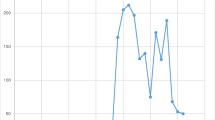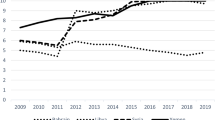Abstract
During recent decades, terrorist groups have sought refuge in weak or failed states from which to launch their attacks. Foreign aid to states harboring those groups may or may not be an effective counterterrorism strategy. The current paper investigates that strategy from resident terrorist groups’ perspectives while accounting for their ideologies. In particular, we investigate how conflict aid and other forms of assistance affect the number of domestic and transnational terrorist incidents perpetrated by resident groups of religious, leftist, or nationalist orientations. Our analysis indicates that aid influences not only resident groups’ terror campaigns but also their survival prospects. Groups’ ideologies play important roles in counterterrorism aid’s effectiveness. To address possible aid-terrorism endogeneity, our regressions rely on novel instruments.



Similar content being viewed by others
Notes
Coggins (2015), Lai (2007), and Piazza (2008) view such states as attracting resident terrorist groups. However, George (2018) offers a different perspective that failing states are unattractive environments for terrorist groups, given their infrastructure shortfalls and residents’ distrust of foreigners.
Kis-Katos et al. (2014) also separate terrorist groups according to their ideologies; however, they explain the determinants of each ideologically based type of attack. We are, instead, interested in how terrorists’ ideologies affect total terrorist attacks and terrorist group survival in light of conflict and governance aid.
In AidData (2017), governance aid corresponds to codes 15000 to 15150.
This exclusion is necessary since no data are available on individual countries’ contributions to conflict or governance aid subsequently given by those organizations.
That conclusion follows because \(\exp \left[ {\ln \left( {1.107} \right) \times \ln \left( {1.01} \right)} \right] - 1 = 0.00101\). Other ln(IRR) values are transformed similarly. Henceforth, we just present the transformed values.
The conclusion follows because \(\exp \left[ {\ln \left( {0.922} \right) \times \ln \left( {1.01} \right)} \right] - 1 = - 0.00081\).
References
Abadie, A. (2006). Poverty, political freedom and the roots of terrorism. American Economic Review, 96(2), 50–56.
AidData. (2017). AidDataCore_ResearchRelease_Level1_v3.1 Research releases dataset. Retrieved August 19, 2019, from http://aiddata.org/research-datasets.
Azam, J.-P., & Delacroix, A. (2006). Aid and the delegated fight against terrorism. Review of Development Economics, 10(2), 330–344.
Azam, J.-P., & Thelen, V. (2008). The roles of foreign aid and education in the war on terror. Public Choice, 135(3–4), 375–397.
Azam, J.-P., & Thelen, V. (2010). Foreign aid versus military intervention in the war on terror. The Journal of Conflict Resolution, 54(2), 237–261.
Bandyopadhyay, S., Sandler, T., & Younas, J. (2011). Foreign aid as counterterrorism policy. Oxford Economic Papers, 63(3), 423–447.
Bandyopadhyay, S., Sandler, T., & Younas, J. (2014). Foreign direct investment, aid, and terrorism. Oxford Economic Papers, 66(1), 25–50.
Bapat, N. A. (2011). Transnational terrorism, US military aid, and the incentive to misrepresent. Journal of Peace Research, 48(3), 303–318.
Bapat, N. A. (2019). Monsters to destroy: Understanding the war on terror. New York: Oxford University Press.
Ben-Itzhak, D. G. D. (2015). Foreign aid and terrorism: When is aid effective in reducing terror? Unpublished dissertation, Political Science, University of Kansas.
Boutton, A. (2019). Of terrorism and revenue: Why foreign exacerbates terrorism in personalist regimes. Conflict Management and Peace Science, 36(4), 359–384.
Boutton, A., & Carter, D. B. (2014). Fair-weather allies? Terrorism and the allocation of US foreign aid. The Journal of Conflict Resolution, 58(7), 1144–1173.
Brandt, P. T., George, J., & Sandler, T. (2016). Why concessions should not be made to terrorist kidnappers. European Journal of Political Economy, 44, 41–52.
Cameron, A. C., & Trivedi, P. K. (2013). Regression analysis of count data. New York: Cambridge University Press.
Campos, N. F., & Gassebner, M. (2013). International terrorism, domestic political instability, and the escalation effect. Economics and Politics, 25(1), 27–47.
Carter, D. B. (2012). A blessing or a curse? State support for terrorist groups. International Organization, 66(1), 129–151.
Choi, S.-W. (2010). Fighting terrorism through the rule of law? The Journal of Conflict Resolution, 54(6), 940–966.
Coggins, B. L. (2015). Does state failure cause terrorism? An empirical analysis (1999–2008). The Journal of Conflict Resolution, 59(3), 455–483.
Danzell, O. E., Kisangani, E. F., & Pickering, J. (2019). Aid, intervention, and terror: The impact of foreign aid and foreign military intervention on terror events and severity. Social Science Quarterly, 100(3), 951–964.
Dreher, A., & Fuchs, A. (2011). Does terror increase aid? Public Choice, 149(3–4), 337–363.
Enders, W., Todd Sandler, T., & Gaibulloev, K. (2011). Domestic versus transnational terrorism: Data, decomposition, and dynamics. Journal of Peace Research, 48(3), 319–337.
Eubank, W. L., & Weinberg, L. B. (1994). Does democracy encourage terrorism? Terrorism and Political Violence, 6(4), 417–435.
Eyerman, J. (1998). Terrorism and democratic states: Soft targets or accessible systems? International Interactions, 24(2), 151–170.
Fleck, R., & Kilby, C. (2010). Changing aid regimes? U.S. foreign aid from the Cold War to the war on terror. Journal of Development Economics, 91(2), 185–197.
Gaibulloev, K., Piazza, J. A., & Sandler, T. (2017). Regime types and terrorism. International Organization, 71(3), 491–522.
Gaibulloev, K., & Sandler, T. (2013). Determinants of the demise of terrorist organizations. Southern Economic Journal, 79(4), 774–792.
Gaibulloev, K., & Sandler, T. (2019). What we have learned about terrorism since 9/11. Journal of Economic Literature, 52(2), 275–328.
Gassebner, M., & Luechinger, S. (2011). Lock, stock, and barrel: A comprehensive assessment of the determinants of terror. Public Choice, 149(3–4), 235–261.
George, J. (2018). State failure and transnational terrorism: An empirical analysis. The Journal of Conflict Resolution, 62(3), 471–495.
Gleditsch, N. P., Wallensteen, P., Eriksson, M., Sollenberg, M., & Strand, H. (2002). Armed conflict 1946–2001: A new dataset. Journal of Peace Research, 39(5), 615–637.
Hou, D., Gaibulloev, K., & Sandler, T. (2020). Introducing extended data on terrorist groups (EDTG), 1970 to 2016. The Journal of Conflict Resolution, 64(1), 199–225.
Kim, W., Li, D., & Sandler, T. (2021). Resident terrorist groups, military aid, and moral hazard: Further empirical analysis. Defence and Peace Economics. https://doi.org/10.1080/10242694.2019.1709783.
Kis-Katos, K., Liebert, H., & Schulze, G. S. (2014). On the heterogeneity of terror. European Economic Review, 68, 116–136.
Kleibergen, F., & Paap, R. (2006). Generalized reduced rank tests using the singular value decomposition. Journal of Econometrics, 133(1), 97–126.
Krueger, A. B. (2007). What makes a terrorist: Economics and the roots of terrorism. Princeton, NJ: Princeton University Press.
Krueger, A. B., & Laitin, D. D. (2008). Kto Kogo? A cross-country study of the origins and targets of terrorism. In P. Keefer & N. Loayza (Eds.), Terrorism, economic development and political openness (pp. 143–173). New York: Cambridge University Press.
Lai, B. (2007). Draining the swamp: An empirical examination of the production of international terrorism. Conflict Management and Peace Science, 24(4), 297–310.
Marshall, M. G., Jaggers, K., & Gurr, T. R. (2018). Polity IV project: Dataset and users’ manual. Vienna, VA: Center for Systemic Peace: Polity IV Project. Retrieved September 23, 2019, from http://www.systemicpeace.org/inscrdata.html.
Pettersson, T., Högbladh, S., & Öberg, M. (2019). Organized violence, 1989–2018 and peace agreements. Journal of Peace Research, 56(4), 589–603.
Piazza, J. A. (2006). Rooted in poverty? Terrorism, poor economic development and social cleavages. Terrorism and Political Violence, 18(1), 159–177.
Piazza, J. A. (2008). Incubators of terror: Do failed and failing states promote transnational terrorism? International Studies Quarterly, 52(3), 469–488.
Piazza, J. A. (2017). Repression and terrorism: A cross-national empirical analysis of types of repression and domestic terrorism. Terrorism and Political Violence, 29(1), 1–17.
Savun, B., & Tirone, D. C. (2018). Foreign aid as a counterterrorism tool: More liberty, less terror. The Journal of Conflict Resolution, 62(8), 1607–1635.
Stock, J. H., & Yogo, M. (2005). Testing for weak instruments in linear IV regression. In W. K. D. Andrews & J. Stack (Eds.), Identification and inference for econometric models: Essays in honor of Thomas Rothenberg (pp. 80–108). Cambridge: Cambridge University Press.
Tierney, M. J., Nielsen, D. L., Hawkins, D. G., Roberts, J. T., Findley, M. G., Powers, R. M., et al. (2011). More dollars than sense: Refining our knowledge of development finance using AidData. World Development, 39(11), 1891–1906.
Walsh, J. I., & Piazza, J. A. (2010). Why respecting physical integrity rights reduces terrorism. Comparative Political Studies, 43(5), 551–577.
Wooldridge, J. M. (2011). Econometric analysis of cross section and panel data. Cambridge, MA: MIT.
Wooldridge, J. M. (2015). Control function methods in applied econometrics. Journal of Human Resources, 50(2), 420–445.
World Bank. (2019). World development indicators (WDI). Retreived October 19, 2019, from http://databank.worldbank.org/ddp/home.do.
Young, J. K., & Findley, M. G. (2011). Can peace be purchased? A sectoral-level analysis of aid’s influence on transnational terrorism. Public Choice, 149(3–4), 365–381.
Acknowledgements
The authors have profited from insightful comments by two anonymous reviewers and William F. Shughart II on earlier drafts.
Funding
Funding was provided by Vibhooti Shukla Endowment at University of Texas at Dallas.
Author information
Authors and Affiliations
Corresponding author
Additional information
Publisher's Note
Springer Nature remains neutral with regard to jurisdictional claims in published maps and institutional affiliations.
Electronic supplementary material
Below is the link to the electronic supplementary material.
Rights and permissions
About this article
Cite this article
Kim, W., Sandler, T. Foreign aid and terrorist groups: incidents, ideology, and survival. Public Choice 189, 139–160 (2021). https://doi.org/10.1007/s11127-020-00866-7
Received:
Accepted:
Published:
Issue Date:
DOI: https://doi.org/10.1007/s11127-020-00866-7
Keywords
- Foreign aid
- Terrorist group survival
- Domestic and transnational terrorism
- Endogeneity
- Aid-recipient host of terrorist groups




